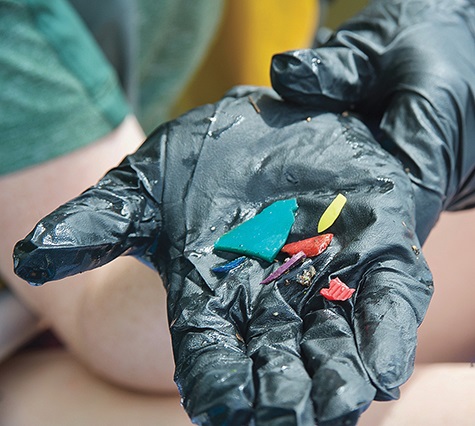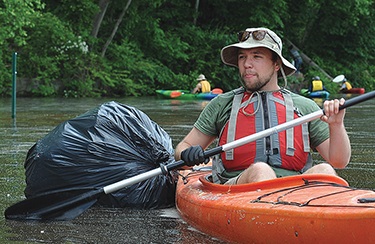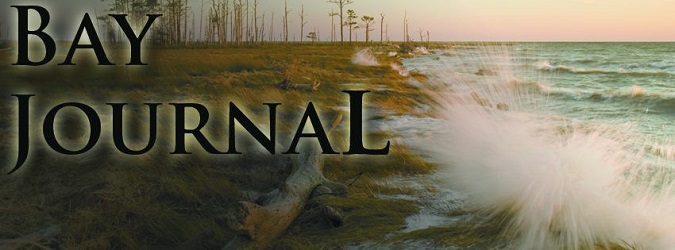
Extremely small bits of plastic are everywhere, and the Chesapeake Bay is no exception. The so-called microplastics, often 5 millimeters or less in size, can be scooped from the surface waters of the Patapsco River and combed from the Bay’s underwater grass beds.
Microplastics that originated as tiny beads in some face scrubs, soaps and toothpastes are now banned by federal law. But most microplastics begin in much larger pieces: chunks of litter and debris — water bottles, car tires and even plastic piers — that break down into increasingly smaller pieces but don’t biodegrade for hundreds of years. Those plastic bits can leach chemicals or become a carrier of toxins and invasive species they pick up as they float through the water.
Scientists now know that single-celled organisms in the aquatic environment can easily mistake the smallest particles of plastics for food. Those bits then travel up the food chain, eaten by larger and larger fish that are eventually eaten by humans.
The Chesapeake Bay Program, a state-federal partnership that leads the Bay restoration effort, has identified microplastics as a contaminant of mounting concern. But, for all of the headlines and anxiety microplastics have generated, a looming question remains unanswered: What harm are they causing in the Bay?
The Bay Program Scientific and Technical Advisory Committee convened a two-day workshop in late April to begin finding answers.
“We might have an idea of the exposure, but on the effect side, we’re not so sure,” said Jerry Diamond, an ecotoxicology and risk management expert with the consulting firm Tetra Tech, at the outset the meeting.
“With a chemical, we can say that this concentration of copper has this effect, so if you have this much in the water it’s not good,” Diamond said. “For microplastics, we don’t have that.”
Research on microplastics and their impact is accelerating around the globe. Scientists know plenty already — though not all applies directly to the Bay or its suite of species. At the workshop, a consensus emerged that more work is needed to measure not just the presence but also the potential harm that microplastics cause when they’re prevalent in the region’s habitats, the bellies of fish and shellfish, and even drinking water.
Connecting data to action
A 2014 report on the presence of microplastics in four Chesapeake rivers appears to be the only peer-reviewed study of its kind in the region. Conducted by the University of Maryland’s Lance Yonkos, and referenced throughout the workshop, the study confirmed that microplastics are more plentiful in surface waters near urban and suburban centers and after heavy rains — and they were found in all but one of 60 samples collected in the Corsica, Magothy, Patapsco and Rhode rivers in 2011.
Yonkos, who has continued to research the abundance of microplastics related to nearby land use, said at the workshop that his study generated as many questions as answers for him.
“Just because we found [microplastics] doesn’t mean they came from there,” Yonkos said. “We need to look more at transport to understand the source.”
Researchers also are beginning to get results from a batch of samples collected from the Bay in 2015 by Trash Free Maryland. The nonprofit group worked with a lab at the University of Toronto to quantify and classify microplastics gathered from the water in 30 locations. They found the highest concentrations in waters near Baltimore and the District of Columbia. Most of the debris has been categorized as fragments from larger plastics, followed by fibers and films.
In 2017, students at Old Dominion University found that microplastics have the potential to carry harmful bacteria and human pathogens such as species of vibrio in the Elizabeth River.
While the scientific work continues, state and federal governments have begun taking action. The District of Columbia, for example, has charged a 5-cent fee for plastic bags since 2010. And this year, New York state enacted a ban on most single-use plastic bags. In 2015, Congress banned the microbeads used as exfoliants in some cleaning products and, this year, Maryland passed a ban on polystyrene foam food containers. Three jurisdictions touching the Anacostia River, including the District and Montgomery and Prince George’s counties, had already passed bans on the products, commonly found in the river.
Since that first bag fee in 2010, several Bay states have considered similar measures. The Chesapeake Bay Commission, made up of legislative representatives from each state, has received questions about how the language of several disparate bills would impact Bay water quality and whether it could be improved. When the commission turned to the scientific community for help, it found a lot of gaps in the research, despite the fact that some jurisdictions were already passing related legislation.
“As a scientist, I thought that, to give people useful information for a piece of legislation, I had to have 95% certainty and all this data,” said Denice Wardrop, a scientist at Penn State and member of Bay Program’s Scientific and Technical Advisory Committee. “You don’t. People are willing to use a legislative tool or management action at a lower level of certainty than we assume.”
That sentiment became Wardrop’s mantra at the April workshop, where scientists grappled with the gap between what they know and what they still need to know about microplastics — and the need to generate a recommendation for the Bay Commission.
Next frontier
Growing evidence suggests that several species in the Bay and its rivers are ingesting microplastics from the water column or in other habitats. More work is needed — and some has already begun — to determine what impact the plastics could have on the health of fish, shellfish and the humans who eat them.
“We’re never going to get down to zero plastics,” said Kay Ho, a marine ecotoxicologist with the U.S. Environmental Protection Agency, who attended the April workshop. “But can we quantify how much is too much?”
Christine Knauss, a Ph.D. student at the University of Maryland Center for Environmental Science at Horn Point, is trying to answer that question for hatchery-spawned oysters. Existing research found that Pacific oyster larvae not only consume polystyrene microbeads but also experience impacts to their growth and reproduction because of it. Knauss wanted to see if the same is true for a Bay oyster species.
After including tiny plastic beads in the feed mix for Crassostrea virginica larvae, Knauss has so far found that the plastics seem to have an impact during their first six days in the larvae’s system, before the larvae excrete most of the beads. During that period, the larvae had higher respiration rates and seemed to clear out their guts more quickly, though growth and mortality did not seem to be heavily impacted.
“I always get [asked] the question of whether [the beads] are actually inside the larvae,” Knauss said, showing a video of the plastics, marked with fluorescent dye, swirling inside a tiny oyster. “They do eat them, and they do get into the gut.”
Knauss said more studies are needed not only in the lab but also in the field, where a combination of factors — from pollution and plastics to climate change and predation — impact the larvae’s ability to grow.
Susanne Brander, a researcher at Oregon State University studying how microplastics impact black sea bass, agreed. Brander, while at the University of North Carolina, began a two-year project on the important East Coast fishery, which visits the lower Chesapeake Bay, where microplastics were found in 60% of black sea bass in the wild.

In the lab, she found that Centropristis striata larvae often discriminated between floating foodstuffs and microplastics — but the single-celled organisms they ate did not. She showed images of microscopic organisms vacuuming tiny plastics into their guts, where they remained when they were eaten by the sea bass.
So far, small black sea bass that consumed microplastics seem to have decreased immune responses and higher cortisol levels, which indicate stress. Their respiration does not appear to have been affected, Brander said.
“Quantifying mortality can be challenging in the lab,” Brander said. “If you think about it, plastics are one more pressure added on top of many other pressures. We always say that more research is needed.”
Bill Ball, executive director of the Chesapeake Research Consortium, said studies like these could be enough to trigger more policy changes in the watershed.
“We need evidence that it’s clearly a pollutant and that it’s harmful. Then society can look at how to reduce it,” he said.
The District of Columbia and Maryland jurisdictions already remove thousands of pounds of trash from the Anacostia River each year under a federal pollution limit that is being rewritten. Trash removals like these and other voluntary programs help quantify where and how plastics enter the river, and they also chip away at removing the debris that’s both an eyesore and a future source of microplastics.
Research on the impact of microplastics, though, has in some ways just begun.
Water treatment processes may come into play too, as scientists learn more about the presence of microplastics in drinking water. The Hampton Roads Sanitation District is working with the Virginia Institute of Marine Science to understand what types of microplastics might be making it through the plant’s treatment process. That question seems more urgent now that the plant is infusing some of its processed water back into the aquifer, where it could become a drinking water source for the future.
Yonkos, the author of that sole Bay-focused microplastics report, is looking for microplastics inside worms and mussels in the Anacostia River to see if they could serve as markers of ecosystem health. He’s also collecting sediment cores from Bay rivers that might now contain microplastics to compare with cores stored away in the lab from the early 1980s.
Even as the body of research around tiny plastics begins to grow, policy makers at the workshop encouraged the group to act quickly to apply new information. The flow of plastics to local waters isn’t expected to ebb anytime soon.
“We don’t want to wait another five years while these animals and habitats are getting clogged with more plastics,” said Kimberly Grubert, a coastal planner at the Maryland Department of Natural Resources, at the close of the workshop. “We need a sense of urgency.”

